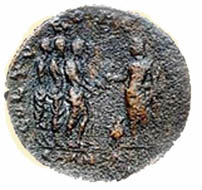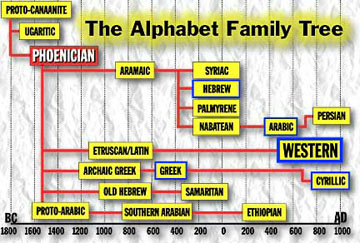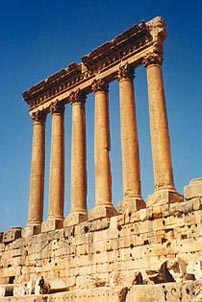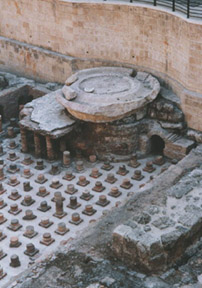Phoenicians
The Ancient People of Lebanon
New! : National Geographic: DNA study reveals ...
The Phoenicians
Canaanites
The recorded history shows a group of coastal cities and heavily forested mountains inhabited by a Semitic people, the Canaanites, around 4000 BC. These early inhabitants referred to themselves according to their city of origin, and called their nation Canaan. They lived in the narrow East-Mediterranean coast and the parallel strip mountains of Lebanon. Around 2800 BC Canaanites traded cedar timber, olive oil and wine from Byblos for metals and ivory from Egypt.
Phoenicians/Canaanites
The Canaanites who inhabited that area were called Phoenicians by the Greeks (from the Greek word phoinos, meaning ‘red’) in a reference to the unique purple dye the Phoenicians produced from murex seashells. The Phoenicians mastered the art of navigation and dominated the Mediterranean Sea trade for around 500 years. They excelled in producing textiles, carving ivory, working with metal and glass. The Phoenicians built several local cities East Mediterranean among which: Byblos, Tyre, Sidon, Berytus (Beirut), Tripoli, Arvad Island-City, Baalbek and Caesarea.
They established trade routes to Europe and Western Asia. Phoenician ships circumnavigated Africa a thousand years before those of the Portuguese. They founded colonies wherever they went in North and South Mediterranean; in Cyprus, Rhodes, Crete, Malta, Sicily, Sardinia, Marseilles, Cadiz, and Carthage around the first Millennium B.C.
 |
| (above) Phoenician colonies around the Mediterranean Sea (first Millennium B.C.) |
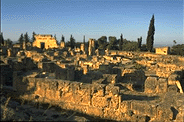 |
(left) Carthage, Tunisia,West Mediterranean, founded
by Phoenician princess Elissa of Tyre 814 BC
(right) Settlement are found on the island of Sardinia, Italy. 7th cent. BC |
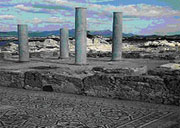 |
Inventing the Alphabet
Around 1600 B.C. the Phoenicians invented 22 ‘magic signs’ called the alphabet, and passed them onto the world. The Phoenicians gave the alphabet to the Greeks who adopted it; the evolution of the Phoenician Alphabet led to the Latin letters of present-day.
|
Constructing Kings David and Solomon Palaces and Temple(for more Details)
The Phoenician king Hiram of Tyre (989-936 BC) built a palace for David and two palaces and a temple for Solomon. The Bible provides a vast amount of information about them.
David’s Palace
King Hiram of Tyre sent a trade mission to David; he provided him with cedar logs and with stonemasons and carpenters to build a palace. (1 Chronicles 14:1)
Solomon’s Temple
After king David’s death, Hiram continued to maintain friendly relations with king Solomon, David’s son, who explained in a letter to Hiram: You know that because of the constant wars my father David had to fight against the enemy countries all round him, he could not build a temple for the worship of the Lord his God until the Lord had given him victory over all his enemies. But now the Lord my God has given me peace on all my borders. I have no enemies, and there is no danger of attack. The Lord promised my father David, ‘Your son, whom I will make king after you, will build a temple for me’ and I have now decided to build that temple for the worship of the Lord my God. (1 Kings 5:3)
Solomon’s temple was built by Phoenician master craftsmen alongside Hebrew workmen and 30,000 unskilled navies pressed by Solomon into forced labor. They worked for a month on and two months off in shifts of 10,000 at a time.
They used wood, stone and metal from Lebanon and worked by Phoenician craftsmen. The temple was finished in 960 BC, taking seven years to build.
Solomon’s palaces
King Solomon built himself a palace and called it 'Forest of Lebanon' and built his Egyptian wife another palace using the Phoenician craftsmen and the materials of Lebanon:
Solomon also built a palace for himself, and it took him thirteen years. The Hall of the Forest of Lebanon was 44 meters long, 22 meters wide,and 13.5 meters high. It had three rows of cedar pillars, fifteen in each row, with cedar beams resting on them. The ceiling was of cedar, extending over store-rooms, which were supported by the pillars. In each of the two side walls there were three rows of windows. The doorways and windows had rectangular frames, and the three rows of windows in each wall faced the opposite rows. The Hall of Columns was 22 meters long and 13.5 meters wide. It had a covered porch, supported by columns. The Throne Room, also called the Hall of Judgment, where Solomon decided cases, had cedar panels from the floor to the rafters. Solomon’s own quarters, in another court behind the Hall of Judgment, were made like the other buildings. He also built the same kind of house for his wife, the daughter of the king of Egypt. (1 Kings 7:1-8)
The Phoenicians adjusted to successive conquerors later and managed to keep their trade business ongoing and kept, sometimes, sorts of political independence.
(875-608 BC) Assyrians invaded Phoenicia in 875 BC and deprived the Phoenicians from their independence. Byblos, Tyre and Sidon rebelled several times and the Assyrians brought total destruction to the cities in response.
(585-538 BC) Babylonians became the new power and occupied Phoenicia. Phoenician cities rebelled and Tyre was destroyed, again.
(538 BC-333 AD) Persians occupied the region including Phoenicia. The Phoenician navy supported Persia during the Greco-Persian war
(490-449 BC) Phoenicians revolted when overburdened with heavy tributes imposed by the Persians forth century BC.
(333 - 64 BC) Greeks defeated Persian troops when Alexander the Great attacked Asia Minor in 333 BC. The Phoenician cities made no attempt to resist and acknowledged Alexander’s suzerainty. However, when he tried to offer a sacrifice to Melkurt, Tyre’s god, the city resisted and he besieged it. The city fell after 6 months of resistance. Alexander’s conquest left a Greek imprint on the area. The Phoenicians, being a cosmopolitan civilization amenable to outside influences, adopted aspects of Greek civilization and continued with their trade business.
(64 BC-600 AD)Romans and Christianity
Romans added Lebanon to the Roman Empire. Economic and intellectual activities flourished in Lebanon during the Pax Roman. The inhabitants of the principal Phoenician cities of Byblos, Sidon and Tyre were granted Roman citizenship. These cities were centers of the pottery, glass and purple dye industries; their harbors also served as warehouses for products imported from Syria, Persia and India. They exported cedar, perfume, jewelry, wine and fruit to Rome. Economic prosperity led to a revival in construction and urban development; temples, palaces and first School of Law in history were built throughout the country, as well as paved roads that linked the cities. Ruins of Roman temples and monuments are found all around Lebanon with the largest in Baalbek.
The Bible tells us about the first women who believed in Christianity and became the first convert outside the Jews to be a Phoenician women. From the Northern Phoenician ports Saint Peter left to Rome and built the first church there.
After the Roman Empire division, the economic and intellectual activities continued to flourish in Beirut, Tyre and Sidon for more than a century.
The fifth century witnessed the birth of Maronite Christianity.
Saint Maroun (also Maron) found a refuge in the northern mountains of Lebanon,
and a great portion of the Phoenicians/Lebanese became Christians and were called
after him. Mronites later had a great contribution in Lebanese history, independence
and culture. Gradually, the area named Phoenicia gave way to Mount Lebanon or
simply Lebanon.
Around the sixth century earthquakes destroyed Beirut and its law school and
damaged the great temples in Baalbek.
|
Phoenicians Legends
The Abduction of Europa
Europa, the Phoenician Princess that overwhelmed Zeus with Love
Zeus, the King of the gods according to Greek mythology, saw Europa, the beautiful daughter of the Phoenician king of Tyre ‘Agenor’, as she was gathering flowers by the Mediterranean sea and fell in love with her.
Overwhelmed by love for Europa, Zeus transformed himself into the form of a magnificent white bull and appeared in the sea shore. The great bull so gentle that Europa spread flowers about his neck and dared to climb upon his back. Then the bull rushed over the sea abducting Europa and took her to the Mediterranean island of Crete. There, Zeus got back into his human form. Europa became the first queen of Crete and had by Zeus three sons: King Minos of Crete, King Rhadamanthus of the Cyclades Islands, and Prince Sarpedon of Lycia. She later married the king of Crete, who adopted her sons, and she was worshiped under the name of Hellotis in Crete. The Hellotia festival was held in her honour. At last, Zeus reproduced the shape of the white bull that was used to seduce Europa, in the stars. Today, we can recognize its shape in the constellation Taurus.
Rise of the Phoenix
The Phoenix Shall Rise, as narrated by Antoine G. Faddoul
The Phoenix, the firebird that comes from Paradise, lives five hundred years feeding on aromatic herbs and filling the air with its heavenly voice, before it perishes and burns in fire. It would then rise from the ashes to live another five hundred years. |
|
|---|---|
For thousands of years, the land that carried the mountains of Lebanon and hugged the Mediterranean Sea was restless. The cedars that the LORD Himself planted on the snowy white mountains of Lebanon witnessed the land's boundaries expanding and shrinking, and those who inhabited the very first civilized cities suffered numerous invasions destroying their cities time and again. However, like the Phoenix, the survivors always rose from the ruins and rebuilt their homeland in a manner even more magnificent than it used to be, while the invaders left, no matter how long they captured the land for. The Phoenix kept flying over Mount Lebanon with fiery and golden feather, spending its life narrating the greatness of the land and its people with its glamorous voice. Through history, the Phoenix could not live its full lifespan, yet it never failed to rise from its ashes to chant the story of a living nation. Click for more, the song, the Phoenix constellation |
|
|
|
Phoenician Links
- Sources
- Khalaf,Salim George. A Bequest Unearthed, Phoenicia -- Encyclopedia Phoeniciana, Chapel Hill, NC, USA, 2003, http://phoenicia.org
- The Holy Bible: II Samuel, I Kings, II Kings, I Chronicles and II Chronicles
- Cyclopean Numerical Proportional Systems, N. Shabshab

